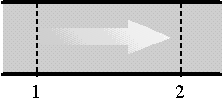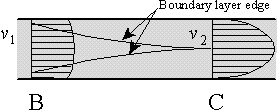Typical head loss values for important situations may be found in
tables. For bends and area changes, they can be expressed as
a head loss coefficient: ![]() .
.

Exercise:
Why express the headloss in terms of? Why not, say,
?
For the developed two-dimensional duct flow in the previous subsection,
the head loss over a distance ![]() of the duct is:
of the duct is:

There will be an additional head loss for the entrance effects (called minor
head loss):

For the duct exit, the kinetic energy will probably be mostly lost:
